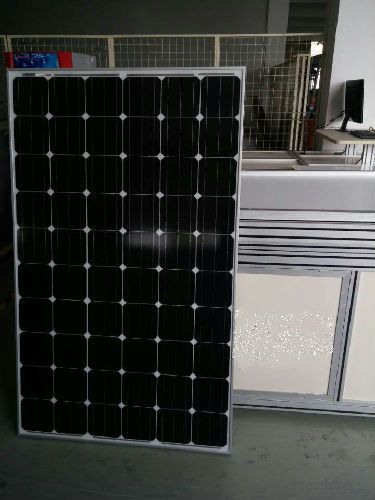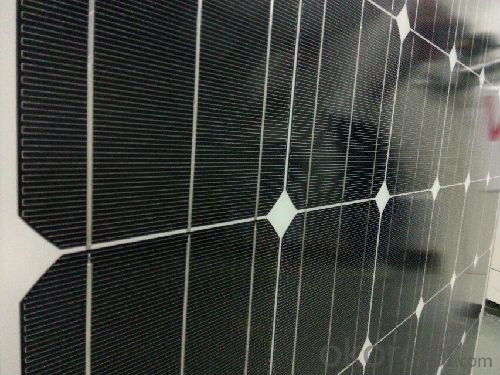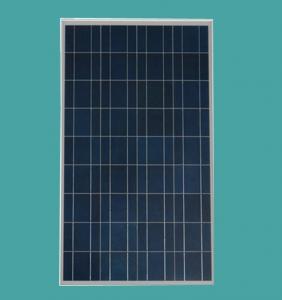Monocrystalline Solar Cells for Solar Panels Energy Product System With TUV,MCS Certificate
- Loading Port:
- Tianjin
- Payment Terms:
- TT or LC
- Min Order Qty:
- 10 m²
- Supply Capability:
- 1000 m²/month
OKorder Service Pledge
OKorder Financial Service
You Might Also Like
Specifications
1.Solar panel energy system power from 165W-195W
2.100% TUV standard flash test
3.Certificate:TUV,UL,MCS
4.Quality Insurance
100% TUV standard flash test mono solar panel energy product system
1.What is 100% TUV standard flash test?
Flash test machine with TUV standard reference solar panel,all Propsolar Panel is tested with 100% TUV standard or standard higher than TUV standard
In the market,not all solar panel is real tested with TUV standard,Flash machine reference panel is not TUV standard,so the power is 2%-3% less than TUV standard.
2.Solar Panel Warranty
1)10 years limited manufacturing warranty
2)12 years for 90% of warranted minimum power
3)25 years for 80% of warranted minimum power
3.Solar Panel Electric Characteristics
CELL TYPE | 125 X 125 MONO SOLAR CELL | ||||||
ITEM | PS-M572165 | PS-M572170 | PS-M572175 | PS-M572180 | PS-M572185 | PS-M572190 | PS-M572195 |
Maximum Power(Wp) | 169.9 | 174.9 | 179.9 | 184.9 | 189.9 | 194.9 | 199.9 |
Open circuit Voltage (Voc) | 43.3 | 43.7 | 44.0 | 44.5 | 44.9 | 45.2 | 45.5 |
Short circuit Current (Isc) | 5.05 | 5.25 | 5.40 | 5.45 | 5.55 | 5.60 | 5.80 |
Maximum Power Voltage (Vm) | 35.3 | 35.5 | 35.6 | 36.0 | 36.3 | 36.5 | 36.7 |
Maximum Power Current (Im) | 4.67 | 4.79 | 4.92 | 5.00 | 5.10 | 5.21 | 5.31 |
Cell Efficiency [%] | 15.85 | 16.33 | 16.81 | 17.28 | 17.77 | 18.25 | 18.74 |
Module Efficiency [%] | 12.88 | 13.27 | 13.66 | 14.05 | 14.44 | 14.83 | 15.22 |

More Details:
Depending on construction, photovoltaic modules can produce electricity from a range of frequencies of light, but usually cannot cover the entire solar range (specifically, ultraviolet, infrared and low or diffused light). Hence, much of the incident sunlight energy is wasted by solar modules, and they can give far higher efficiencies if illuminated with monochromatic light. Therefore, another design concept is to split the light into different wavelength ranges and direct the beams onto different cells tuned to those ranges.[citation needed] This has been projected to be capable of raising efficiency by 50%. Scientists from Spectrolab, a subsidiary of Boeing, have reported development of multijunction solar cells with an efficiency of more than 40%, a new world record for solar photovoltaic cells.[3] The Spectrolab scientists also predict that concentrator solar cells could achieve efficiencies of more than 45% or even 50% in the future, with theoretical efficiencies being about 58% in cells with more than three junctions.

The life of the solar panels is determined by the Solar Energy Solar Cells, tempered glass, EVA, TPT and other materials, usually with better materials manufacturers panels made out of life can reach 25 years, but with the impact on the environment, solar cell board materials will change with time and aging. Normally used in 20 years of power will decay by 30%, it will be used in 25-year power attenuation of 70%.
Inspection and Maintenance of Solar Energy Solar Cells:
1. Check whether the damaged Solar Energy Solar Cells, to be promptly found and replaced.
2. Check the battery cables and the ground plate is good contact, without loss phenomenon.
3. Check the wiring at the combiner box if there is fever phenomenon.
4. Check the battery plate bracket loose and breakage.
5. Cleaning up around the panels shielding panels weeds.
6. Check whether the panel surface coverings.
7. Check the battery guano on the plate surface, and clean it if necessary.
8. The cleanliness of the panels were identified.
9. Windy weather to deal with solar panels and frame to conduct audits.
10. Snow days to respond in a timely manner to clean up the panel, the panel surface to avoid the frozen snow.
11. Heavy rain should check all waterproof seal is good, whether the water leakage.
12. Check if there are animals into the power station to the battery plate damage.
13. Hail response panel surface to conduct audits.
14. The battery plate temperature is detected, and the ambient temperature is compared for analysis.
15. Check it out on the issues to be addressed promptly analyzed and summarized.
16. To do detailed records of each inspection, in order to analyze later.
17. Summary records for analysis and archiving.
- Q:Can solar cells be used to power emergency lighting systems?
- Yes, solar cells can be used to power emergency lighting systems. Solar cells convert sunlight into electricity, which can be stored in batteries for use during emergencies or when there is a power outage. This makes them a reliable and sustainable source of power for emergency lighting systems.
- Q:Can solar cells be damaged by hail or other weather conditions?
- Yes, solar cells can be damaged by hail or other severe weather conditions. Hailstones or strong winds can cause physical damage to the surface of solar panels, leading to cracks or breakages. Additionally, extreme heat or cold can affect the efficiency and lifespan of solar cells. Therefore, it is important to consider the weather conditions and install appropriate protection measures to safeguard solar panels.
- Q:What is the impact of snow accumulation on solar cells?
- Snow accumulation on solar cells can have a negative impact on their performance and efficiency. When snow covers the surface of the solar panels, it prevents sunlight from reaching the cells, thereby reducing their ability to generate electricity. Additionally, the weight of the accumulated snow poses a risk of damaging the delicate solar cells or the entire panel structure. Therefore, it is important to regularly clear the snow from solar panels to ensure optimal energy production and prevent any potential damage.
- Q:Is it complicated to make a solar cell work well?
- A solar cell is a physical and chemical phenomenon.
- Q:Do solar cells work in cloudy weather?
- Yes, solar cells can still generate electricity in cloudy weather, although their efficiency is reduced compared to when they are exposed to direct sunlight.
- Q:How do solar cells convert sunlight into electricity?
- Solar cells convert sunlight into electricity through a process called the photovoltaic effect. The cells are made of semiconductor materials, usually silicon, that absorb photons from the sunlight. These absorbed photons excite the electrons in the material, allowing them to break free from their atomic bonds. The freed electrons then flow through the cell's material, creating an electric current. This current can be harnessed and used as electricity to power various devices and systems.
- Q:What is a good introduction of solar cell?
- A small and simple test on the solar cell can be good to start with.
- Q:Can solar cells be used for powering electric fences?
- Yes, solar cells can be used for powering electric fences. Solar cells convert sunlight into electrical energy, which can be stored in batteries and used to power electric fences. This provides a sustainable and environmentally-friendly solution for powering fences in areas where access to grid electricity is limited or expensive.
- Q:What is the maintenance required for solar cells?
- The maintenance required for solar cells primarily involves regular cleaning to remove any dirt, debris, or grime that may accumulate on the surface of the panels. Additionally, it is important to inspect the panels for any damage, such as cracks or loose connections, and address them promptly to ensure optimal performance. Other routine maintenance tasks include checking the inverters, monitoring the system's performance, and keeping the surrounding area free from shading objects. Overall, solar cell maintenance is relatively minimal compared to other energy sources, making it a cost-effective and sustainable choice for power generation.
- Q:What is a polymer solar cell and how does it work?
- Polymer solar cell is a type of flexible solar cell made with polymers.
1. Manufacturer Overview |
|
|---|---|
| Location | |
| Year Established | |
| Annual Output Value | |
| Main Markets | |
| Company Certifications | |
2. Manufacturer Certificates |
|
|---|---|
| a) Certification Name | |
| Range | |
| Reference | |
| Validity Period | |
3. Manufacturer Capability |
|
|---|---|
| a)Trade Capacity | |
| Nearest Port | |
| Export Percentage | |
| No.of Employees in Trade Department | |
| Language Spoken: | |
| b)Factory Information | |
| Factory Size: | |
| No. of Production Lines | |
| Contract Manufacturing | |
| Product Price Range | |
Send your message to us
Monocrystalline Solar Cells for Solar Panels Energy Product System With TUV,MCS Certificate
- Loading Port:
- Tianjin
- Payment Terms:
- TT or LC
- Min Order Qty:
- 10 m²
- Supply Capability:
- 1000 m²/month
OKorder Service Pledge
OKorder Financial Service
Similar products
New products
Hot products
Hot Searches
Related keywords




























